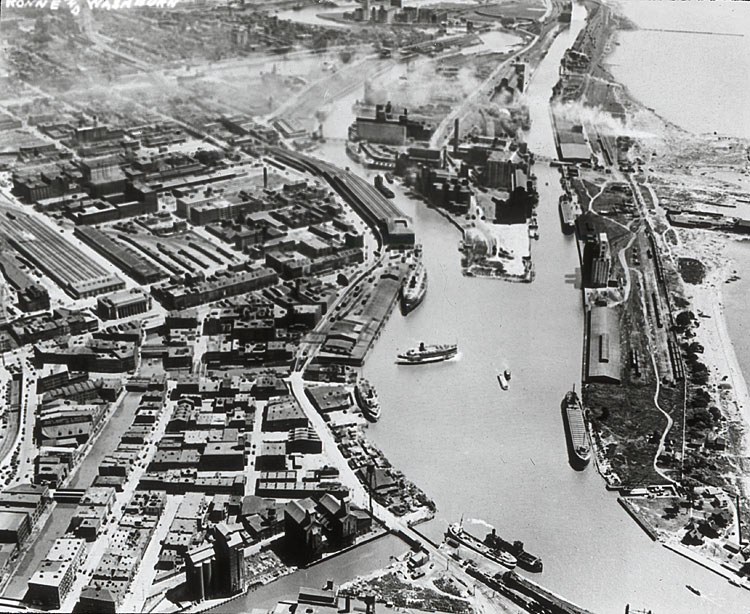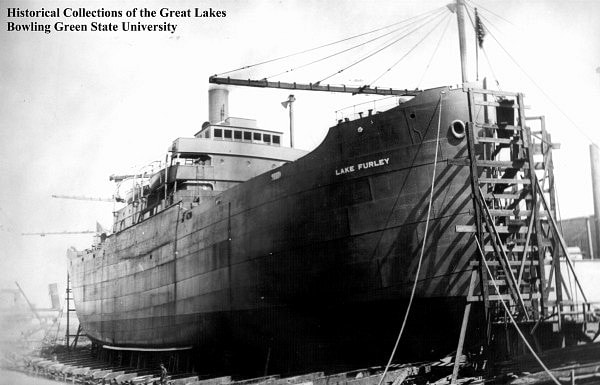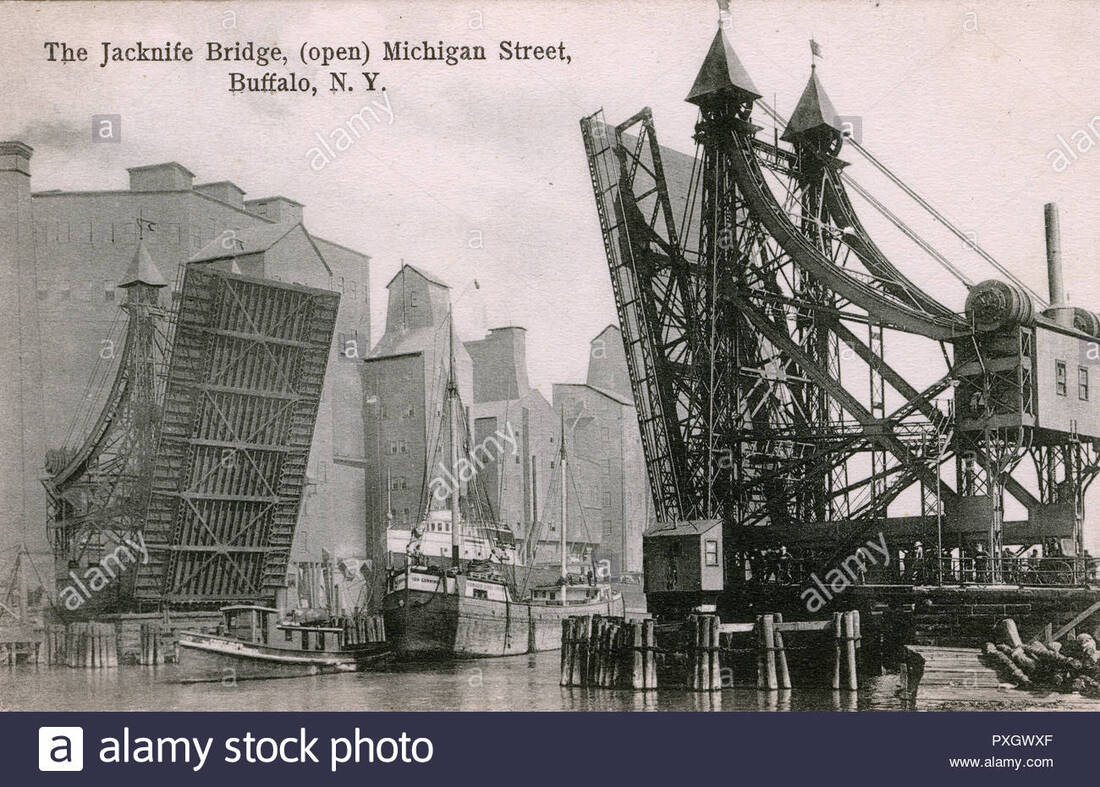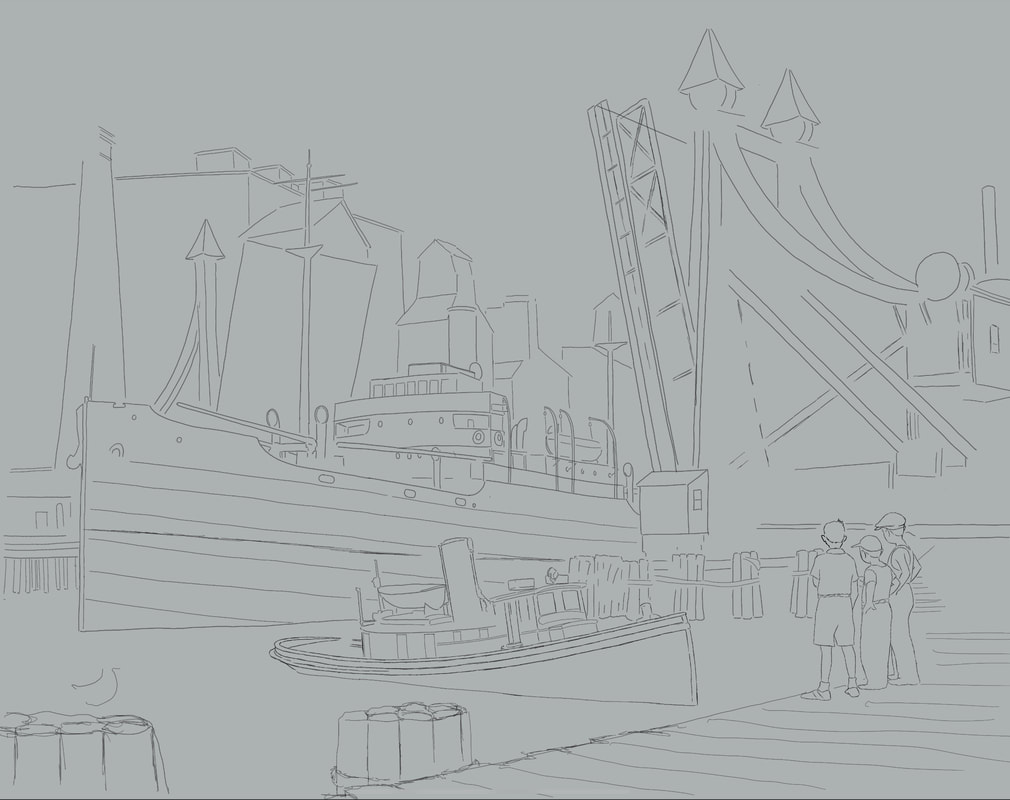|
What could be better than the marriage of two life-long passions? Maritime history and art have been an absolute joy to pursue and explore, and it’s my good fortune to live in an area that offer both in abundance. As I learn to create art that’s more illustrative and, hopefully, more realistic and interesting, one thing is clear: to emulate the artists I most admire who followed a clearly defined process, I need to define my own. After some trial and error, step one is research - online, through archives, and in-person at the locations of the events I’m hoping to paint. Going from a broad, geographic view, then focusing in on places and objects within that area, I start with the Buffalo harbor and waterfront from the first half of the nineteenth century. Buffalo was positively booming with commerce, travel, transportation, architecture - a bustling city that ranked second only to New York City in size and wealth during that era. Aerial view of Buffalo Harbor taken in 1924. The topic most interesting to me, at least at this time, is the ships and shipbuilding that were conducted in Buffalo - ships, some of whom went on to see service with merchant fleets during the Second World War and were tragically lost in the Battle of the Atlantic to wolf packs of lethal German U-Boats. Others outlived their usefulness and were scrapped by the Ford Motor Company only a few short years after their completion, having been built in 1918 to supply the materials of a war that ended within a year of their launch. In particular, “Lakes” class freighters that had the stereotypical tramp steamer appearance - tubby, squat, but built solidly enough to survive the brutal North Atlantic Ocean in time of war. Somewhere in the neighborhood of a dozen of these vessels were built in Buffalo by the American Shipbuilding subsidiary, the Buffalo Drydock Company. The Lake Furley, as seen nearing completion at the Buffalo Drydock Company in 1919. Sadly, her career was brief and ended as scrap for the Ford Motor Company only seven short years after this photo was taken. Having selected a key object to include in a future painting or paintings, as the case is likely to be, it’s time to determine the setting. Another captivating element of Buffalo history is its architecture, or in this case, it’s infrastructure. The Lake Furley would have slid down the building ways into the Buffalo River, and proceeded west beyond the Michigan Street Jackknife Bridge, itself an engineering marvel. After a good deal more research, including drives to where it once had spanned, and photos of the area as it now appears, I chose the open, and beautifully constructed bridge as part of the picture I want to make. The Michigan Street Jackknife bridge, which spanned the Buffalo River from 1897-1929. In order for a picture to connect most effectively, there has to be a human element. Fortunately, the Buffalo area is rich in historical imagery of the waterfront and the activities that took place there. Images of “Scoopers”, or the men (often Irish immigrants), who climbed into the deep and dangerous holds of grain-laden vessels to shovel, or scoop the grain as it was loaded and off-loaded are fascinating to view and might find a place in a painting. Images of children standing at the dock’s edge to watch the ships narrowly passing one another, and vintage photos of dock workers, fishermen, and casual onlookers from the period all offer interest that could be included. Small harbor tug boats, with their crews standing by to receive or cast off lines on deck, and their captains attentive at the wheel as they negotiate a busy commercial waterway with very little room for error offers additional possibilities. Finally, it’s time to begin sketching - the place in the process I am now. Taking all the interesting elements, and placing them within a limited space to make the picture interesting, historically accurate (or as accurate as can reasonably be achieved without sacrificing the story we’re trying to tell with the picture), and believable with respect to perspective, color, and values - not an easy task. This is my first, rough sketch which will constitute the under-drawing of my future digital painting. I’ve included the Lake Freighter passing through the Jackknife Bridge, the buildings that were in existence in the background at the time, a harbor tug meandering near the pier, and the kids of the era watching it all as it takes place. The sketch has more work to be done - one of the things I’ve learned painfully and repeatedly is the painting suffers when all the small details aren’t worked out beforehand. This sketch is a compilation of vintage images, altered to suit my purposes in picture-making, and which will hopefully become a digital painting worth the time to view - stay tuned. The first, unfinished sketch which includes all the elements of interest I want for my painting.
2 Comments
6/21/2021 12:03:33 pm
Very interesting, I never knew Buffalo had such an active maritime history. Please continue with more.
Reply
Dian Vanderploeg
6/21/2021 12:32:07 pm
This will be a remarkable painting. I love the sketch. As you flesh it out, it will become rich and alive. Thank you for bringing this exciting history into being.
Reply
Leave a Reply. |
AuthorIllustrator and Cartoonist Archives
February 2022
Categories |
Proudly powered by Weebly




 RSS Feed
RSS Feed